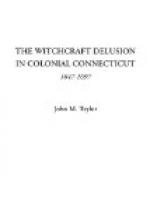GOODY BASSETT. Stratford, 1651. Executed.
“The Gouernor, Mr. Cullick, and Mr. Clarke are desired to goe downe to Stratford to keepe courte uppon the tryall of Goody Bassett for her life”—May, 1651. “Because goodwife Bassett when she was condemned” (probably on her own confession, as in the Greensmith case). Colonial Records of Connecticut (1: 220); New Haven Colonial Records (2: 77-88).
GOODWIFE KNAPP. Fairfield, 1653. Executed.
“After goodwife Knapp was executed, as soon as she was cut downe.” New Haven Colonial Records (1: 81).
Full account in previous chapter.
ELIZABETH GODMAN. New Haven, 1655. Acquitted.
Elizabeth was released from prison September 4, 1655, with a reprimand and warning by the court. New Haven Town Records (2: 174, 179); New Haven Colonial Records (2: 29, 151).
Account in previous chapter.
NICHOLAS BAYLEY and WIFE. New Haven, 1655. Acquitted.
Nicholas and his wife, after several appearances in court on account of a suspicion of witchcraft, and for various other offenses—among them, lying and filthy speeches by the wife—were advised to remove from the colony. They took the advice.
WILLIAM MEAKER. New Haven, 1657. Accused acquitted.
Thomas Mullener was always in trouble. He was a chronic litigant. His many contentions are noted at length in the court records. Among other things he made up his mind that his pigs were bewitched, so “he did cut of the tayle and eare of one and threw into the fire,” “said it was a meanes used in England by some people to finde out witches,” and in the light of this porcine sacrifice he charged his neighbor William Meaker with the bewitching. Meaker promptly brought an action of defamation, but Mullener became involved in other controversies and “miscarriages,” to the degree that he was advised to remove out of the place, and put under bonds for good behavior; and Meaker, probably feeling himself vindicated, dropped his suit. New Haven Colonial Records (2: 224).
ELIZABETH GARLICK. Easthampton, 1658. Acquitted.
Records Particular Court (2 :113); Colonial Records of Connecticut (1: 573); STILES’ History of Windsor (p. 735).
Account in previous chapter.
NICHOLAS and MARGARET JENNINGS. Saybrook, 1661.
Jury disagreed.
The major part of the jury found Nicholas guilty, but the rest only strongly suspected him, and as to Margaret, some found her guilty, and the others suspected her to be guilty. It is probable that the Jennings were under inquiry when, at a session of the General Court at Hartford, June 15, 1659, it was recorded that “Mr. Willis is requested to goe downe to Sea Brook, to assist ye Maior in examininge the suspitions about witchery, and to act therin as may be requisite.” Records Particular Court (2: 160-3); Colonial Records of Connecticut (1: 338).




